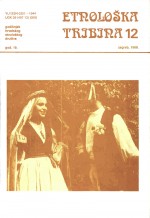Strategije održanja životnosti i očuvanja kulturnih vrijednosti u muzeološkoj antropologiji: primjer rukotvorstva i obrta jastrebarskog kraja
Traditional and Surviving Crafts of Jastrebarsko Area in the Regional Museum of Jastrebarsko
Author(s): Dragica Cvetan-ŽakulaSubject(s): Museology & Heritage Studies, Customs / Folklore, Cultural Anthropology / Ethnology, Post-War period (1950 - 1989)
Published by: Hrvatsko etnološko društvo
Keywords: museological anthropology; Jastebarsko; crafts; tradition; culture;
Summary/Abstract: The crafts of Jastrebarsko area are represented according to a specific concept which includes both active and passive presentation. Jastrebarsko is located thirty kilometer from Zagreb and was an important crafts center since the 13th century. Urban and rural craftsmen alike specialized in smithery, tayloring, shoe-making, weaving, tanning, masonry, wagon-making etc. Only a few of these activities are still alive; therefore all of them need to be recorded, reconstructed and presented. The Regional Museum of Jastrebarsko, located in the medieval Erdödy castle, gives special treatment to the presentation of these crafts. First permanent exhibition of traditional material culture in the Museum was put together by a group of local amateur enthusiasts in 1965. It was taken down in 1987, when the restoration of the castle began. All the exhibitions mentioned have illustrated catalogs with English summaries which, along with video and other documentation, explain and make possible the reconstruction of traditional skills. Thus, the strategy of survival and cultural preservation of traditional crafts in the Jastrebarsko area includes: 1. The »pasive« presentation of artisans’ tools and products, enlivened by photo, dia and video recordings of the labor process. 2. Occasional presence of still active craftsmen on the Museum premises, demonstrating their skill. 3. Presentation of crafts outside o f the Museum, in the context of »natural« continuing function of village fairs. An ethnologist adds to them specific museological and educative content and purpose. All three forms of presentation of traditional crafts could, perhaps, be synthesized by an innovative form: once the Erdödy castle is restored, indoor museum exhibition, craftsmen demonstrations and »village fair« in the castle’s courtyard could be attractively combined. In this way, a new form is attained that contains both the image of medieval life and post-modern concept of eco-museum.
Journal: Etnološka tribina : Godišnjak Hrvatskog etnološkog društva
- Issue Year: 19/1989
- Issue No: 12
- Page Range: 133-141
- Page Count: 9
- Language: Croatian

